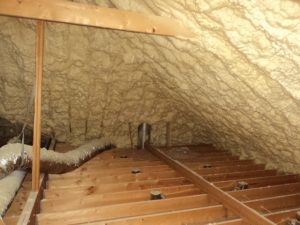Is Spray Foam Insulation the Next Housing Crisis in the US?
Is Spray Foam Insulation the Next Housing Crisis in the US?
Spray foam insulation, once celebrated for its energy efficiency and environmental benefits, is now under intense scrutiny in the United Kingdom. A recent article from the BBC highlights the significant problems homeowners face with spray foam insulation, including reduced mortgage options, structural damage, and resale challenges. These issues have led many to wonder: could the United States experience a similar crisis?
The UK Spray Foam Problem
In the UK, spray foam insulation has been a popular option for homeowners seeking better energy efficiency. However, its use has come with unforeseen consequences. Mortgage lenders are now hesitant to approve loans for homes with spray foam insulation due to concerns about structural damage and difficulty assessing roof conditions. Some homeowners have found their properties devalued or deemed unmortgageable because of poorly installed or improperly maintained insulation. (BBC)
The UK’s experiences highlight a cautionary tale for other countries. Spray foam insulation, while effective in theory, can lead to long-term issues when not properly installed or monitored. These challenges are particularly alarming for homeowners and inspectors who must navigate the lasting impact of such decisions.

Spray Foam Insulation in the US: Growing Popularity, Growing Risks
The United States has seen a similar rise in the use of spray foam insulation, praised for its ability to seal air leaks, lower energy costs, and improve indoor air quality. In states with extreme weather fluctuations, like North Carolina or Texas, the material has become a go-to solution for energy-conscious homeowners. However, its widespread adoption raises concerns about whether the US might soon face similar problems to those emerging in the UK.
Several risks associated with spray foam insulation are already being observed by private home inspectors across the country, including:
1. Moisture Trapping and Structural Damage:
• When improperly installed, spray foam insulation can trap moisture, leading to wood rot, mold growth, and compromised structural integrity. This is particularly problematic in humid regions of the US.
2. Inspection and Maintenance Challenges:
• Spray foam insulation often covers critical structural components, making it difficult for inspectors to assess roofs, attic spaces, and HVAC systems. Undetected issues can snowball into costly repairs.
3. Reduced Home Value:
• Like in the UK, some US homeowners report difficulty selling homes with spray foam insulation, especially when lenders or buyers view it as a risk rather than an asset.
4. Installer-Related Variability:
• The quality of spray foam insulation heavily depends on the skill of the installer. Inconsistent application, incorrect mixtures, or insufficient curing can create long-term problems.
The Role of Home Inspectors
Home inspectors in the US are increasingly voicing concerns about spray foam insulation. Many inspectors note that the material, while excellent for energy efficiency, can create blind spots during property evaluations. Inspectors often find themselves advising clients about the potential risks of spray foam insulation, particularly regarding hidden moisture or the inability to inspect key components.
Moreover, private inspectors worry that the growing popularity of spray foam could lead to future liabilities. As seen in the UK, these materials could render homes less marketable or even uninsurable if problems arise.
Lessons from the UK
The UK experience provides a roadmap for the US to avoid a widespread crisis. Key takeaways include:
1. Education for Homeowners:
• Homeowners must understand both the benefits and risks of spray foam insulation. Proper education can help them make informed decisions about installation and maintenance.
2. Standards and Certification for Installers:
• The US should adopt stricter regulations and certification requirements for spray foam insulation installers to minimize installation-related issues.
3. Mortgage Industry Awareness:
• Lenders should consider the implications of spray foam insulation when underwriting loans, but also work toward standardized criteria rather than blanket rejections.
4. Collaboration with Home Inspectors:
• Home inspectors should be trained to better assess properties with spray foam insulation, even when access is limited. Improved inspection methods could help detect hidden risks.
Preparing for the Future
Spray foam insulation’s rise in popularity in the United States is a double-edged sword. While it offers undeniable benefits for energy efficiency, the potential for hidden issues could lead to significant challenges for homeowners, lenders, and inspectors alike.
To mitigate these risks, the US must learn from the UK’s experience. Proactive measures, such as standardized installation protocols, improved inspection practices, and better homeowner education, will be essential in avoiding a full-blown crisis. For home inspectors, this means staying ahead of the curve by understanding the risks associated with spray foam and advocating for better inspection standards.
As the housing market evolves, vigilance will be key to ensuring that innovative materials like spray foam insulation enhance, rather than hinder, the value of American homes.
